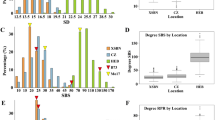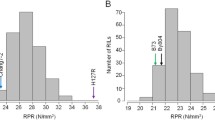Abstract
Stalk lodging in maize causes annual yield losses between 5 and 20% worldwide. Many studies have indicated that maize stalk strength significantly negatively correlates with lodging observed in the field. Rind penetrometer resistance (RPR) measurements can be used to effectively evaluate maize stalk strength, but little is known about the genetic basis of this parameter. The objective of this study was to explore a genetic model and detect quantitative trait loci (QTL) of RPR and determine relationships between RPR and other stalk traits, especially cell wall chemical components. RPR is quantitative trait in nature, and both additive and non-additive effects may be important to consider for the improvement of RPR. Nine additive-effect QTLs covering nine chromosomes, except chromosome 5, and one pair of epistatic QTLs were detected for RPR. CeSA11 involved in cellulose synthesis and colorless2 involved in lignin synthesis were identified as possible candidate genes for RPR. Internode diameter (InD), fresh weight of internode (FreW), dry weight of internode (DryW), fresh weight and dry weight as well as cell wall components per unit volume significantly positively correlated with RPR. The internode water content (InW) significantly negatively correlated with RPR. Notably, these traits significantly correlated with RPR, and the QTLs of these traits co-localized with those of RPR. The corresponding results obtained from correlation analysis and QTL mapping suggested the presence of pleitropism or linkage between genes and indicated that these different approaches may be used for cross authentication of relationships between different traits.

Similar content being viewed by others
Abbreviations
- ADF/V:
-
Acid detergent fiber content per unit volume of internode
- ADL/V:
-
Acid detergent lignin content per unit volume of internode
- CEL/V:
-
Cellulose content per unit volume of internode
- CF/V:
-
Crude fiber content per unit volume of internode
- DryW:
-
Dry weight of internode
- DryW/V:
-
Dry weight of internode per unit volume
- FreW:
-
Fresh weight of internode
- FreW/V:
-
Fresh weight of internode per unit volume
- IBPE:
-
The internode below the primary ear
- InD:
-
Internode diameter
- InL:
-
Internode length
- InW:
-
Internode water content
- NDF/V:
-
Neutral detergent fiber content per unit volume of internode
- QTL:
-
Quantitative trait loci
- RIL:
-
Recombinant inbred line
- RPR:
-
Rind penetrometer resistance
- SCS:
-
Stalk crushing strength
References
Appenzeller L, Doblin M, Barreiro R et al (2004) Cellulose synthesis in maize: isolation and expression analysis of the cellulose synthase (CesA) gene family. Cellulose 11:287–299
Bai QL, Chen SJ, Dong XL et al (2004) Prediction of NDF and ADF concentration with near infrared reflectance spectroscopy (NIRS). Spectrosc Spectr Anal 24:1345–1347
Bai QL, Chen SJ, Dong XL et al (2006) Prediction of IVDMD with near infrared reflectance spectroscopy (NIRS) in maize stalk. Spectrosc Spectr Anal 26:271–274
Bernardo O, Rosa AM, Rogelio S, Ana B (2010) QTL mapping for Mediterranean corn borer resistance in European flint germplasm using recombinant inbred lines. BMC Genomics 11:174–183
Brien BA, Avigne WT, McCarty DR, Koch KE (2011) Expression Analysis of the cellulose synthase (CesA) gene family indicates that CesA10, CesA11, and CesA12 are strongly, though not exclusively associated with secondary cell wall biosynthesis. Maize Genetics Conference Abstracts
Chen SJ, Song TM (2002) High oil mutants from EMS pollen mutagenesis in maize. J China Agric Univ 7(3):12
Feng G, Liu ZF, Li YY et al (2009) Genetics of lodging tolerance to maize stem puncture. Acta Agron Sin 35(11):2133–2138
Flint-Garcia SA, Jampatong C, Darrah LL, McMullen MD (2003) Quantitative trait locus analysis of stalk strength in four maize populations. Crop Sci 43:13–22
Gou L, Huang JJ, Zhang B et al (2007) Effect of population density on stalk lodging resistant mechanism and agronomic characteristics of maize. Acat Agron Sin 33:1688–1695
Gou L, Huang JJ, Sun R et al (2010) Variation characteristic of stalk penetration strength of maize with different density-tolerance varieties. Transactions of the CSAE 11:156–161
Han J, Wang HW, Chen SJ (2008) QTL mapping of kernel oil content of chromosome 6 in a high oil maize mutant (Zea mays L.). Genet Genomics 30(4):373–382
Hoisington D, Khairallah M, Gonzalezdeleon D (1994) Laboratory protocols, 2nd edn. CIMMYT Applied Molecular Genetics Laboratory, Mexico
Hu JD, Bao YP, Luo FH et al (2000) Research on technology for measuring crop rind penetrometer resistance. J Henan Agric Univ 34(1):77–80
Jia ZS, Bai YX (1992) Study on identification of lodging in maize inbred line. China Seeds 3:30–32
Kong FL (2007) Quantitative genetics in plants. China Agricultural University Press, Beijing
Li YH, Qian Q, Zhou YH et al (2003) BRITTLE CULM1, which encodes a COBRA-like protein, affects the mechanical properties of rice plants. Plant Cell 15:2020–2031
Li DX, Li HY, Zhou LD (2004) Selection and estimation of indices of stem-lodging resistance in corn. J Northwest Science-Technology Univ Agric For 32(5):53–55
Ma QH (2009) The expression of caffeic acid 3-O-methyltransferase in two wheat genotypes differing in lodging resistance. J Exp Bot 60(9):2763–2771
McRostie GP, MacLachlan JD (1942) Hybrid corn studies. Sci Agric 22:307–313
Roussel V, Gibelin C, Fontaine AS, Barriere Y (2002) Genetic analysis in recombinant inbred lines of early dent forage maize. II. QTL mapping for cell wall constituents and cell wall digestibility from per se value and top cross experiments. Maydica 47:9–20
Senior ML, Heun M (1993) Mapping maize microsatellites and polymerase chain reaction confirmation of the targeted repeats using a CT primer. Genome 36:884–889
Shenk JS, Westerhaus MO (1991) Population structuring of near infrared spectra and modified partial least square regression. Crop Sci 31:1548–1555
Sibale EM, Darrah LL, Zuber MS (1992) Comparison of two rind penetrometers for measurement of stalk strength in maize. Maydica 37:111–114
Taylor NG, Scheible W, Cutler S, Somerville CR, Turner SR (1999) The irregular xylem3 locus of Arabidopsis encodes a cellulose synthase required for secondary cell wall synthesis. Plant Cell 11:769–779
Thompson DL (1963) Stalk strength of corn as measured by crushing strength and rind thickness. Crop Sci 3:323–329
Tong PY (2010) Maize is promoted to “the king of grains” in China. Agric Sci Technol Commun 9:5–6
Utz HF (2010) PLABSTAT: a computer program for statistical analysis of plant breeding experiments, Version3A. Institute of Plant Breeding, Seed Science, and Population Genetics, University of Hohenheim, Stuttgart, Germany
Wang HW (2009) QTL analysis and genetic relationship between kernel compositions and stalk nutrition quality traits in high oil maize population. Dissertation, China agricultural university
Wang DL, Zhu J, Li ZK, Paterson AH (1999) Mapping QTLs with epistatic effects and QTL × environment interactions by mixed linear model approaches. Theor Appl Genet 99:1255–1264
Wang J, Zhou JM, Lin QQ et al (2006) The effects of culm structure and cell wall components on crushing strength in wheat. Chin Sci Bull 51(5):1–7
Wang HW, Han J, Sun WT, Chen SJ (2010a) Genetic analysis and QTL mapping of stalk digestibility and kernel composition in a high-oil maize mutant (Zea mays L.). Plant Breed 129:318–326
Wang JK, Li HH, Zhang LY et al (2010b) Users’ manual of QTL IciMapping V3.0, Chinese Academy of Agricultural Sciences, Beijing
Weng LY (2010) Status of corn production in China and its countermeasures. Food Nutr China 1:22–25
Wu J (2004) Analysis on stalk components and silage nutritional value of high oil corn. Dissertation, China agricultural university
Yang J, Hu CC, Ye XZ, Zhu J (2010) QTL Network 2.2 user manual: software for mapping QTL with epistatic and QE interaction effects. Zhejiang University, Hanzhou
Yao QL (2003) Studies of the inheritance of stalk breaking resistance traits in maize. J Southwest Agric Univ 25(2):123–126
Zhu J (2000) Mixed linear model approaches for analyzing genetic models of complex quantitative traits. J Zhejiang Univ (Sci) 1(1):78–90
Zuber MS, Grogan CO (1961) A new technique for measuring stalk strength in corn. Crop Sci 1:378–380
Zuber MS, Colbert TR, Bauman LF (1977) Effect of brown-midrib-3 mutant in maize (Zea mays) on stalk strength. Z Pflanzenzuecht 79:310–314
Acknowledgments
This research was supported by Modern Maize Industry Technology System of China (No. nycytx-02) and national projects (No.2011AA10A103 and No. 2009CB118400). We thank Prof. Utz in University of Hohenheim, Dr. Wenxin Liu and Haochuan Li in China Agricultural University for their comments and suggestions during the preparation of this manuscript.
Author information
Authors and Affiliations
Corresponding author
Additional information
Communicated by T. Luebberstedt.
H. Hu and Y. Meng contributed equally to this work.
Rights and permissions
About this article
Cite this article
Hu, H., Meng, Y., Wang, H. et al. Identifying quantitative trait loci and determining closely related stalk traits for rind penetrometer resistance in a high-oil maize population. Theor Appl Genet 124, 1439–1447 (2012). https://doi.org/10.1007/s00122-012-1799-5
Received:
Accepted:
Published:
Issue Date:
DOI: https://doi.org/10.1007/s00122-012-1799-5




